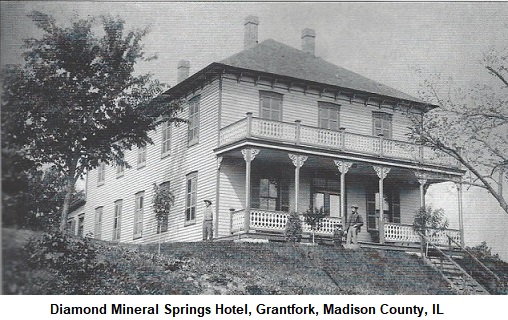Early History of Grantfork
The village of Grantfork (just north of Highland), at the
intersection of Hwy. 160 and Pocahontas Road, lies partly in Leef
and partly in Saline Townships. The town was first called Fitz
James, and was laid out in 1840 by Henry K. Lathey, James Carpenter,
George Fulls, Jonas R. Gale, Z. Lowe, and William F. De Wolf, on the
southwest quarter of section 33. John Duncan opened a store there in
1840. His house stood on the north side of the road that runs on the
township line. He kept a public house, and put up a large sign
inscribed in prominent letters – “Fitz James Hotel by John Duncan.”
He lived there until his death, after which the buildings were
destroyed by fire.
Martin Ruch, in the early history of the village, opened a store on
the south side. In 1840, Mr. Herrin opened a blacksmith shop in a
little log cabin, that stood just east of the Douglas store. John
Link was the second blacksmith.
In 1862, Stephen Bardill opened a stone quarry and lime kiln west of
Grantfork. He later sank a shaft for a coal mine on the property,
but it was abandoned because of flooding.
Some years later, the town was making little progress. R. D. Leggitt
put up a second store, which stood on the north side of the road.
After two years, he sold out to William Schum, who subsequently sold
to John Bardill and brothers. Mr. Bardill later purchased his
brother’s interest in the store, and conducted the business for many
years. He was instrumental in getting a post office established
called Saline. The postal department ordered the name changed, and
the citizens christened the town Grantfork.

In 1886, the water which flooded the Bardill mine was tested and was
revealed to contain minerals. The Diamond Mineral Springs Hotel was
erected, and the mineral springs developed into a health and summer
resort. Back in the days when travelers visited the State capital in
Vandalia, they would stop at the hotel to enjoy mineral baths and a
good night’s rest. The property was sold to Anton Kraft in 1891, who
further developed it by enlarging the lake and converting the
grounds to a park, with fountains and flower-lined walks. He updated
the system of waterworks for the hotel, and added an amusement hall
for dancing and billiards. A dining hall was constructed for guests
in 1892, and expanded in 1937 when the hotel operation ceased and
the Krafts concentrated on the restaurant business. The hotel was
torn down in 1957, but the restaurant continued under the name of
the Diamond Mineral Springs Restaurant, which is still open (2019)
at 1 West Pocahontas Road, Highland.
The Catholics erected a brick church in 1872. A school was connected
with this church. The Lutheran Church was erected also in 1872, and
was a brick structure. The Grantfork public school was a brick
building, one story high, with two rooms.
Businesses in Grantfork in 1882:
Physicians – A. R. Ransom and A. Sacconi
General Store and Postmaster – Martin Ruch
Hotel – Anton Kraft
Drugstore – A. Sacconi
Blacksmith Shops – Charles Schmitt, Nic Mollett, and Theodore
Schwartz
Wagon Shops – G. Winter, Nic Mollett
Harness Shop – E. Salzmann
Butcher – F. Landolt
Tinsmith and Stoves – Joseph Miller
Undertaker – F. Oswald
Shoemaker – G. Zweifel
Daniel Ruedy was chosen as a member of the Board of Supervisors in
1876. He was succeeded by John Bardill in 1879. John Mulloy was
elected in 1880.